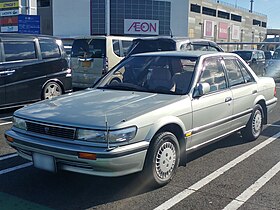
Back Nissan Bluebird Afrikaans نيسان بلوبيرد Arabic Nissan Bluebird German نیسان بلوبرد Persian Nissan Bluebird Finnish Nissan Bluebird French Nissan Bluebird ID Nissan Bluebird Italian 日産・ブルーバード Japanese 닛산 블루버드 Korean
| Nissan Bluebird | |
|---|---|
 Nissan Bluebird (U12) | |
| Overview | |
| Manufacturer | Nissan |
| Production | 1955–2001 (until 2007 in China) |
| Body and chassis | |
| Class | Compact car |
| Body style | 4-door sedan 4-door hardtop sedan 2-door coupé 5-door station wagon |
| Layout | Front-engine, rear-wheel-drive (1955–1983) Front-engine, front-wheel-drive (1983–2007) Front-engine, four-wheel-drive (1991–2001) |
| Chronology | |
| Successor | Nissan Altima (America) Nissan Primera (Europe) Nissan Pintara (Australia) Nissan Teana (Asia) Nissan Lannia (China)[citation needed] |
The Nissan Bluebird (Japanese: 日産・ブルーバード, Hepburn: Nissan Burūbādo) is a compact car produced between 1955 and 2007 with a model name introduced in 1957. It was Nissan's most internationally recognized sedan, known for its dependability and durability in multiple body styles. The Bluebird originated from Nissan's first vehicles, dating to the early 1900s, and its traditional competitor became the Toyota Corona. The Bluebird was positioned to compete with the Corona, as the Corona was developed to continue offering a sedan used as a taxi since the Toyota Crown was growing in size. Every generation of the Bluebird has been available as a taxi, duties that are shared with base level Nissan Cedrics. It is one of the longest-running nameplates from a Japanese automaker. It spawned most of Nissan's products sold internationally, and has been known by a number of different names and bodystyles, including the Auster/Stanza names.